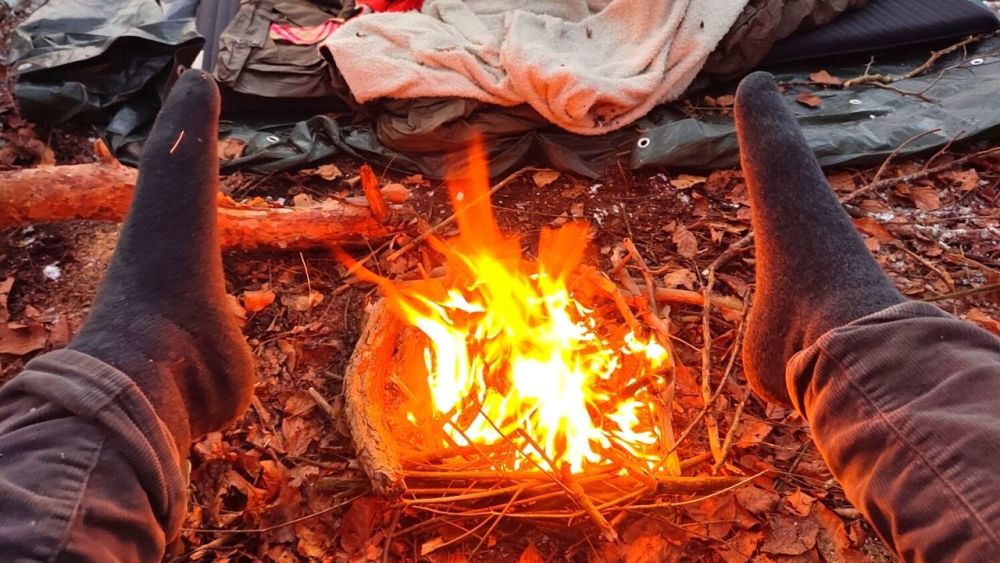
warmth
Noun
Meaning
Warmth is a crucial element in the world of survival, bushcraft, and outdoor activities. It refers to the ability to maintain a comfortable body temperature in challenging environments. In the wilderness, where temperatures can drop drastically, staying warm is essential for your well-being and survival. Whether you're camping, hiking, or facing an emergency situation, understanding how to generate and retain warmth is vital. This includes techniques such as building a fire, insulating your shelter, layering clothing, and using appropriate gear. By prioritizing warmth, you increase your chances of staying safe and comfortable in the great outdoors.

Examples
„I love spending time in the wilderness, and one of the most important things to consider is warmth.“
„When I go camping in the winter, I always make sure to pack extra layers to keep me warm throughout the night.“
„In a survival situation, finding a source of warmth is crucial for staying alive.“
„My friend and I were hiking in the mountains when a snowstorm hit, and we had to quickly build a shelter to protect ourselves from the cold and maintain warmth.“
„When you're out in the wild, knowing how to start a fire is essential for creating warmth and cooking food.“
Origin
The word "warmth" originates from the Old English word "weormth", which is derived from the Proto-Germanic word "warmithaz". This word is ultimately rooted in the Proto-Indo-European word "gʷʰer-", meaning "warm" or "hot".
Throughout history, the concept of warmth has been essential for human survival. In ancient times, people relied on fire and warm clothing to protect themselves from the cold. The word "warmth" has evolved to encompass not only physical warmth but also emotional and psychological warmth.
In the context of survival and bushcraft, warmth is a crucial element. It refers to the ability to maintain a comfortable body temperature in challenging outdoor conditions. This can be achieved through various means, such as proper clothing, shelter, and fire-making skills.
Understanding how to generate and retain warmth is vital in wilderness survival situations, as exposure to extreme cold can lead to hypothermia and other life-threatening conditions. By mastering the art of creating warmth, you increase your chances of staying safe and comfortable in the wild.
Historical and cultural importance
Warmth is a word that holds immense historical and cultural significance. Throughout human history, the quest for warmth has been a fundamental aspect of survival. From ancient civilizations to modern societies, the ability to create and maintain warmth has played a crucial role in our daily lives.
In ancient times, fire was discovered, marking a significant milestone in human evolution. Fire not only provided warmth but also offered protection from predators, cooked food, and facilitated social interactions. The discovery of fire revolutionized our ability to survive in harsh environments and paved the way for the development of civilizations.
Across different cultures, warmth has been associated with comfort, security, and well-being. In many indigenous communities, traditional practices and techniques for creating warmth have been passed down through generations. These practices often involve using natural materials like animal hides, furs, and plant fibers to insulate dwellings and clothing.
Furthermore, warmth holds symbolic meaning in various cultural traditions. It is often associated with love, compassion, and hospitality. The act of offering warmth to others, whether through a cozy fire, a warm meal, or a comforting embrace, is seen as an expression of care and connection.
In the context of survival and outdoor activities, warmth is a critical element. Understanding how to create and maintain warmth in challenging environments is essential for wilderness enthusiasts, hikers, and adventurers. Knowledge of fire-making techniques, insulation methods, and proper clothing choices can mean the difference between comfort and discomfort, or even life and death, in extreme conditions.
Overall, warmth is not just a physical sensation but a concept deeply rooted in our history and culture. It represents our ability to adapt, connect, and thrive in the face of adversity.
More information about the term warmth
The Importance of Warmth in Survival
When it comes to survival in the wilderness, one of the most crucial elements to consider is warmth. In extreme conditions, maintaining a proper body temperature can mean the difference between life and death. In this article, we will explore the importance of warmth in survival and discuss various methods to stay warm in challenging environments.
Why is Warmth Important?
Our bodies rely on a stable internal temperature to function properly. When exposed to cold temperatures, our bodies start to lose heat, which can lead to hypothermia. Hypothermia occurs when the body's core temperature drops below 95 degrees Fahrenheit (35 degrees Celsius). It can cause confusion, loss of coordination, and even cardiac arrest.
By staying warm, we can prevent hypothermia and maintain our physical and mental capabilities. Warmth is essential for our overall well-being and survival in harsh conditions.
Methods to Stay Warm
There are several methods to stay warm in survival situations. Let's explore some of the most effective ones:
Layering Clothing
Layering clothing is a fundamental technique to trap heat and insulate the body. Start with a moisture-wicking base layer to keep sweat away from your skin. Add an insulating layer, such as fleece or wool, to provide warmth. Finally, wear a waterproof and windproof outer layer to protect against the elements.
Building a Shelter
A well-built shelter can provide protection from the cold and wind. Look for natural materials like branches, leaves, and moss to construct a sturdy shelter. Make sure to insulate the floor with debris or additional layers of leaves for added warmth.
Starting a Fire
A fire not only provides heat but also serves as a psychological boost in survival situations. Learn how to build a fire using various techniques, such as friction or using a fire starter. Collect dry tinder, kindling, and fuel wood to keep the fire going.
Using Insulating Materials
Insulating materials like blankets, sleeping bags, or emergency bivvies can help retain body heat. Carry these items in your survival kit to provide an extra layer of warmth when needed.
Keeping Active
Physical activity generates body heat, so keep moving to stay warm. Engage in light exercises or tasks that require movement to maintain your body temperature.
Conclusion
Warmth is a critical aspect of survival in the wilderness. By understanding the importance of warmth and implementing various methods to stay warm, you can increase your chances of survival in challenging conditions. Remember to layer your clothing, build a shelter, start a fire, use insulating materials, and keep active to maintain a stable body temperature. Stay warm, stay safe!
Back to overview

